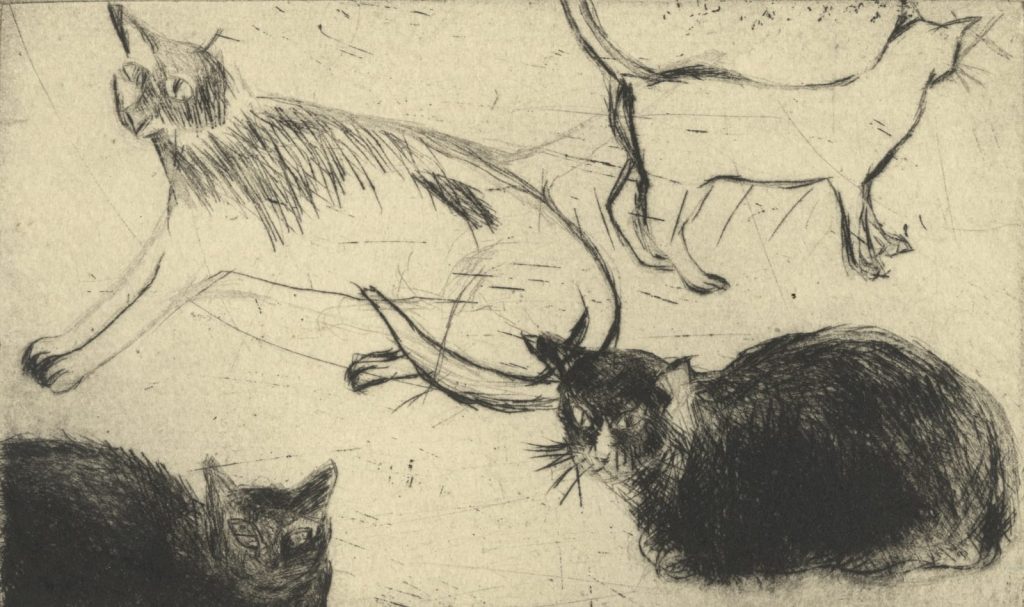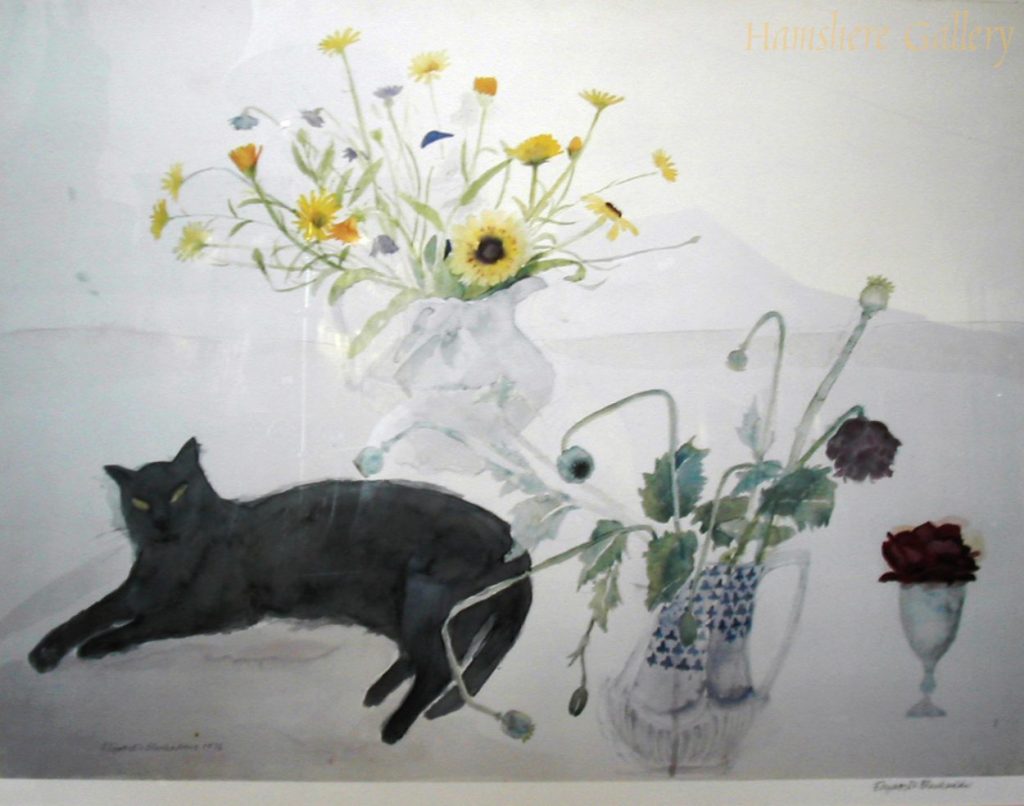Paw Prints: The Diversity of Cats in Japanese Art
From cute and exotic pets to monstrous, otherworldly creatures, cats in Japanese art appear in various forms and contexts. Let’s delve into the...
Iolanda Munck 21 January 2025
Delicate and detailed, the cat paintings of Elizabeth Blackadder are an absolute delight. This is someone who lived with and loved her feline friends. Her art is exquisite and lyrical and definitely worth a closer look!
Dame Elizabeth Violet Blackadder was a Scottish painter and printmaker, known for her delicate still-life canvases, highly detailed botanical works, and for her cat paintings. This is not the cliché tale of a tortured artist – Elizabeth Blackadder was a much-loved artist, who led a long and happy life.

Elizabeth Blackadder, Sleeping Cat, 1984, private collection. The Great Cat.
Born in 1931, Blackadder received support from both of her parents in her dream to become a painter. Her father, an engineer, taught her to draw but sadly he passed away when she was only 10 years old. However, her mother lovingly continued to encourage her aspirations. As a child, Blackadder was a voracious reader. She was also a keen botanist, amassing a gorgeous collection of pressed flowers, meticulously labeled in Latin.

Elizabeth Blackadder, Cats and Flowers, Fleming Collection, Fleming-Wyfold Art Foundation, London, UK
Blackadder pursued her dream, studying and then teaching at Edinburgh College of Art. In 1962 she married John Houston, a distinguished member of the postwar Scottish school. After graduating with a first-class honors degree in art, she traveled through Europe, later visiting Japan. Blackadder was fascinated by the Eastern techniques and subject matter she saw there. Her interest in the concept of Zen and how to include “negative” empty space within the canvas had a profound effect on her artistic development.

Elizabeth Blackadder, Two Cats and Flowers, 1980, Ayton West Gallery, Llanbrynmair, Wales, UK.
The space between the flowers is as important as the flowers themselves.
Obituary by Charles Darwent. The Guardian, 25 August 2021.

Elizabeth Blackadder, Venice Cats II, 2013, Glasgow Print Studio, Glasgow, Scotland, UK.
Elizabeth Blackadder was the first woman to be elected to both the Scottish Academy and the Royal Academy. Her landscape works are held by Tate London, MOMA New York, and the Scottish National Gallery. She was also awarded an Order of the British Empire for her contribution to art, becoming Dame Blackadder. Her tender work even featured on a set of Royal Mails stamps. Snobbish art critics point to the fact that her work is reproduced on cards, notelets, and tea towels in museum gift shops, as proof that she was producing nothing but “pretty pictures”. In fact, her art was based on a firm grasp of art history and a precise, almost scientific, attention to detail.

Elizabeth Blackadder, Puskas (Siamese) and Tigger (Tabby), British postage stamp, 1995, Royal Mail, UK.
So many artists have chosen cats as their studio companions. Why is this? Perhaps the cat, who provides warmth and friendship while also being very independent, suits the more distracted artistic mind? A studio can be a lonely place, and the cat brings life and vigor. And keeps the mice from nibbling your brushes!

Elizabeth Blackadder, Louis in a box, 2013, Academicians’ Gallery, Royal Scottish Academy, Edinburgh, Scotland, UK.
Our reverence for cats seems to be global—in ancient Egypt, the cat was divine; in the Islamic world cats were loved by Mohammed; In Japan, Bakeneko predicts the future; in Norse mythology, the wagon of Freyja, Odin’s wife, was pulled by cats; in Celtic myths, a cat-sith can steal your soul!

Elizabeth Blackadder, Toby, 2011, Glasgow Print Studio, Glasgow, Scotland.
Cats are, of course, a lesson in consent. Woe betide the person who grabs a cat and tries to force an interaction! Cats demand control, independence, and agency. They teach us with sound, body language, and claws to respect their boundaries. However, when a cat chooses you for an ear scratch or a gentle head-butt, or curls up purring in your lap, or does that ‘I love you’ slow blink? Well, then you are the luckiest human! Cats set strong personal boundaries for themselves, and isn’t that a vital lesson to us in how to set our own boundaries and respect those of others?

Elizabeth Blackadder, Black cat with vase of flowers, 1976. The Great Cat.
Which rather neatly brings us to witches, because of course, cats have been associated with witchcraft as familiars. Patriarchs who sought to subdue women exercising their own power and agency decried them as witches. Both the woman and the cat were symbolic of sorcery and sensuality, of darkness and demons. However, Blackadder’s cats are certainly not demonic – they are the epitome of luxurious affection and mellow laziness.

Elizabeth Blackadder, Cats on a Kelim, 1978, Brighton and Hove Museums, Brighton, UK.
Leonardo da Vinci is quoted as saying “the smallest feline is a masterpiece” and with Elizabeth Blackadder, we have a multitude of small masterpieces. She died in 2021 but remains a much-loved and admired artist both within Scotland and the wider art world.
DailyArt Magazine needs your support. Every contribution, however big or small, is very valuable for our future. Thanks to it, we will be able to sustain and grow the Magazine. Thank you for your help!